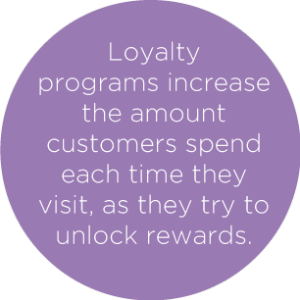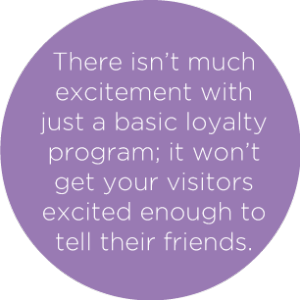When kids inevitably wanted to do or wear something that almost all of their peers were, most of them probably heard their mom or dad say something along the lines of “If all your friends were jumping off a bridge, would you do that too?”
If you were anything like me growing up, it was usually met with a dramatic eye roll and an intense pouting session because it meant you weren’t going to get the item in question – but the wisdom behind it is sound. Just because something is popular doesn’t necessarily make it good, and it is always a good idea to think for yourself.
Should you jump on the customer rewards program bandwagon?
In the business world, however, there are certain elements that are near-ubiquitously implemented across the board, especially in large, Fortune 500 companies. Either they have been around long enough to be unanimously seen as essential, or enough businesses have established them as valuable practices that you’d be giving yourself and your business a competitive disadvantage by instituting.
Although the list of these must-have business aspects would be fairly long, one that would immediately stand out near the top of most people’s list would be a loyalty rewards program.
Loyalty marketing has been around for decades and the advantages (increased customer spending, higher retention, consumer evangelizing, etc.) are well-known – it’s no surprise to find out that nearly every Fortune 500 company has some sort of loyalty marketing program.
Is putting a loyalty program in place something that is wise for a small or medium-sized business, or is it something that should wait until they become a bit larger? We’ll examine that question, as well as look at some notable examples of large companies who have or had boring, uninspired loyalty programs.
Download our free customer loyalty success guide to learn how to drive customers back 2x more.
The value of implementing a customer loyalty program
 The positive benefits of having a loyalty program that we touched on above are well known and have been covered at length in this blog before, so we’ll just briefly touch on them to highlight their value for small businesses.
The positive benefits of having a loyalty program that we touched on above are well known and have been covered at length in this blog before, so we’ll just briefly touch on them to highlight their value for small businesses.
They increase the frequency of customer visits, which is huge. They also increase the amount customers spend each time they are in your business, as they are likely to be trying to unlock rewards.
They help market your business 24/7 as happy customers are much more likely to talk to their friends and family about their positive experiences at your business if they are an actively engaged customer (and many studies have shown that word of mouth is far and away the most effective form of advertising).
They also help you track spending habits and see which items are most popular, what days and times are the busiest, and which things are most commonly purchased in tandem – this in turn helps you create applicable sales and promotions for items during the times you know they are in demand.
If loyalty reward programs are so great, why isn’t every business using them for their customers?
With all these positive aspects, why wouldn’t every business on the face of the planet have a loyalty program? Well, for starters, they take work to get up and running, especially for small businesses that have limited resources in terms of bandwidth and marketing support.
You could just start a very basic punch-card type of system where purchasing a set amount of items unlocks a free one – it takes hardly any thought or research, and minus the cost of printing the cards and buying a hole-punch, doesn’t cost anything. But there isn’t much excitement behind such a black-and-white loyalty program, and it probably won’t get your consumers excited enough to tell their friends about it, which is one of the best benefits of such a program.
Also, unless you invest in some sort of proprietary hole-punch or stamp system, they can be alarmingly easy to counterfeit. And there is no way to track the effectiveness of a cardboard card.
So how can small businesses compete with larger companies that have the marketing muscle and pocket depth to come up with truly innovative programs that feature advanced swipe cards and lucrative loyalty rewards?
New technology allows small businesses to have robust customer loyalty programs like Fortune 500s
What many have turned to over the past few years are third-party programs that specialize in getting high-value and highly-polished loyalty reward programs up and running for small businesses. For a price that is surprisingly manageable and well worth the benefit of having an effective program in place, some companies, like yours truly, will handle everything for you and provide you with a loyalty program and rewards like those seen at Fortune 500s, but for a fraction of the cost.
Digital loyalty programs are now easier to implement and customizable
As Ellen Lee wrote on Intuit’s Small Business Blog, “These startups are harnessing newer technologies (think cloud computing, tablets, and smartphones) to enable small enterprises to deploy customer loyalty programs easily — without paying exorbitant upfront costs. Through these services, small businesses pay a monthly subscription to offer a loyalty program. They can then customize it, such as designating how customers can earn points. For instance, not only can customers rack up points by making a purchase, they can also receive points by posting a message about the business on Facebook or Twitter.”
Digital loyalty programs do much of the heavy lifting for you
 There is a lot of work that these companies will handle for you and your small business, and most of it will likely be things that you don’t have the bandwidth or expertise to run effectively.
There is a lot of work that these companies will handle for you and your small business, and most of it will likely be things that you don’t have the bandwidth or expertise to run effectively.
They will provide you with spending data and other customer information that you can utilize. They can handle getting the word out about your loyalty program and the rewards offered on social media. They will work with partner companies to get the best rewards available for your budget.
Most importantly, they will give your small business a professional, distinctly “big company” feel when your customers walk in and complete a purchase.
Having a polished reward program with a swipe card is something typically seen at much larger companies, and for a small monthly fee you can have that level of polish for your business, even if it’s a one-man shop.
The risk of not doing customer loyalty right
An inspiring, creative, and polished reward system will launch your small or medium-sized business into the realm of the big boys on the block in terms of loyalty marketing. If you can’t set up the program yourself or lack the time and/or knowledge, look toward third party companies to set it up for you. Because while the value of having a loyalty rewards program should be obvious by now, the damage a bad one can cause is probably worse than not having one at all, as some big companies have learned.
 Take Subway for example, one of the largest restaurant chains in the world. Until 2005, they had a stamp card system called the Sub Club which allowed customers to earn free meals after the requisite amount of stamps was given. But, as mentioned above, people counterfeited their stamps and Subway saw rampant fraud throughout the country.
Take Subway for example, one of the largest restaurant chains in the world. Until 2005, they had a stamp card system called the Sub Club which allowed customers to earn free meals after the requisite amount of stamps was given. But, as mentioned above, people counterfeited their stamps and Subway saw rampant fraud throughout the country.
Now, they have a points system implemented that is hardly a great value – $75 spent earns customers a free $5 foot-long, and $100 earns a premium foot-long sub. Hardly a great value, and compared to the previous system, it’s no wonder many Subway loyal customers were highly upset at the switch.
Chico’s clothing store is another big company that has a fairly uninspiring loyalty program. Barring special deals or discounts for first-time buyers just enrolling, their Passport system requires quite a bit of money spent before earning any type of reward. Until you spend $500, customers are locked into the Preliminary Passport tier of the program, which only has the benefits of email notifications for sales and promotions, and being able to view new collections via email.
After you spend $500, you’re in the full-fledged program, but that only comes with a paltry 5% discount and one-time specials such as birthday bonuses and invites to private showings. So for your first $1,000 spent in Passport, you could conceivably only save $25 (the five percent on the second $500 spent).
Take the time to launch a polished and creative loyalty program
While companies as large as Subway and Chico’s can afford to have an uninspired, boring, low-value rewards program, odds are you can’t as a small business owner. Taking the time to understand the purpose behind a successful program and utilizing the benefits you will get out of it is the most important first step – being honest with yourself and evaluating whether or not you have the time and skill to run it is the next.
If not, there are companies that will do it for you for a fraction of the cost – and who knows, maybe the reason all those Fortune 500 companies got so big is due to their polished, successful, creative loyalty program. Since most of them have one, it’s a chicken or the egg scenario – be sure to hatch your own to give yourself the best chance at success.






If all big companies need a loyalty program, then how do you explain Apple?